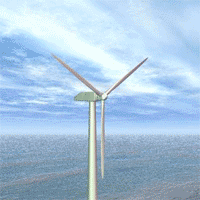This post from Scitizen.com appeared on HuffingtonPost.com and provides some breakthrough parameters for comparing avian deaths from windpower farms to fatalities caused by the structures and pollution from other energy sources.

Save Birds by Promoting Wind Power Development
by Dr. Benjamin K. Sovacool
One could be tempted to think, after reading the more than 600 studies about wind farms and the deaths of birds and bats read by this author the past year, that the evidence linking wind turbines with avian mortality is indisputable.
Birds, for instance, can directly crash into a turbine blade when they are fixated on perching or hunting and pass through its rotor plane; they can strike its support structure; they can hit part of its tower; or they can collide with its associated transmission and distribution lines.
We are told that these risks are exacerbated when turbines are placed on ridges and upwind slopes, built close to migration routes, or operated during periods of poor visibility such as fog, rain, and at night. Some species, such as bats, face additional risks from the rapid reduction in air pressure near turbine blades, which can cause internal hemorrhaging through a process known as barotraumas. Indirectly, wind farms can positively and negatively physically alter natural habitats, the quantity and quality of prey, and the availability of nesting sites.
Yet the deluge of studies making such claims, while useful and important, nonetheless suffers from three common problems. Studies rarely compare their results with studies of other wind farms to contextualize their estimates, instead relying on a narrow sample size. Most do not compare the possible avian deaths from wind electricity with other sources, and when they do, studies typically do not compare them to other energy sources. None have so far attempted to calculate the number of avian deaths per kWh from energy sources so that more meaningful comparisons might be made between different forms of electricity supply.
In an attempt to address some of these shortcomings, one new albeit preliminary study conducted by this author has compared the avian deaths per GWh from three electricity systems: wind farms, fossil-fueled power plants (coal, natural gas, and oil generators), and nuclear power plants.
Avian wildlife can perish not only by striking wind turbines in the ways described above, but by smashing into nuclear power plant cooling structures, transmission and distribution lines, and smokestacks at fossil-fuel fired power stations. Birds can starve to death in forests ravaged by acid rain, ingest hazardous and fatal doses of mercury, drink contaminated water at uranium mines and mills, or die in large numbers as climate change wreaks havoc on migration routes and degrades habitats.
For wind turbines, the risk appears to be greatest to birds striking towers or turbine blades and for bats suffering barotrauma. For fossil-fueled power stations, the most significant fatalities come from climate change, which is altering weather patterns and destroying habitats that birds depend on. For nuclear power plants, the risk is almost equally spread across hazardous pollution at uranium mine sites and collisions with draft cooling structures. When these avian deaths are correlated with the units of electricity those power plants produce, some may find the results surprising. Based on real world operating experience of 339 wind turbines comprising six wind farms constituting 274 MW of installed capacity in the U.S., average avian mortality for wind appears to be about 0.269 fatalities per GWh.
Based on real world operating experience for two coal facilities as well as the indirect damages from mountain top removal coal mining in Appalachia, acid rain pollution on wood thrushes, mercury pollution, and anticipated impacts of climate change, average avian mortality for fossil fueled power stations appears to be about 5.18 fatalities per GWh. Based on real world operating experience at four nuclear power plants and two uranium mines and mills, average avian mortality for nuclear systems is about 0.416 GWh.
In terms of birds killed per electricity produced, nuclear power is slightly worse but comparable to wind energy, but fossil-fueled facilities are about 17 times more dangerous to birds on a per kWh basis. In absolute terms, since wind turbines produced a relatively small amount of national electricity in the United States in 2006, they may have killed about 7,000 but fossil fueled stations killed 14.5 million and nuclear power plants 327,000.
Clearly, wind energy is not as bad for birds as many environmentalists make it out to be, and conventional resources are much more damaging to birds than is commonly believed.





